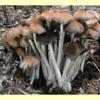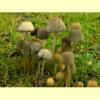
images/Coprinellus/Coprinus_micaceus_TM_DSCN4781a.jpg
Small to medium agaric, growing on the ground, litter or mulch, wood, dung or among bryophytes, with a black, rarely dark brown or purple-brown spore print. Pileus white, pale, yellow, brown or grey, rarely orange, often with patches or small scales remaining from the universal veil, not viscid. Lamellae free, adnexed or adnate. Stipe central. Partial veil remnants absent. Fruit-body usually deliquescent, but autodigestion occasionally slow or not occurring at all (especially in C. disseminatus). Spores reddish brown, brown, greyish or black, smooth; germ pore broad, rarely narrow. Cheilocystidia present or absent; pleurocystidia present or absent. Lamellar trama regular to interwoven with age. Pileipellis a hymeniderm or an epithelium (can be misinterpreted as cutis due to overlying veil remnants, although these are usually globose); usually with projecting pileocystidia. Clamp connections present or absent.
Coprinellus is distinguished from other members of
Coprinus (in the broad sense) by the hymeniderm pileipellis mostly with distinct pileocystidia (although these are absent in
C. micaceus and some other species) and often with an overlying veil of globose elements. The pileipellis structure contrasts with
Coprinopsis and
Coprinus sensu stricto, where there is a cutis and pileocystidia are absent. In
Parasola, which shares with
Coprinellus a hymeniderm pileipellis, the fruit-body is collapsing (rather than truly deliquescent) with a strongly sulcate pileus, pleurocystidia are always present, and pileocystidia are lacking (in Australian species). Other genera with a black spore print and a hymeniderm or epithelioid pileipellis (such as
Panaeolus and
Psathyrella) are not deliquescent.
Coprinellus P.Karst., Bidrag Kännedom Finlands Natur Folk 32 [Ryssl. Hattsvamp. 1]: xxviii, 542 (1879).
About a dozen species reported, with further species expected: Coprinellus angulatus (after fire), C. curtus, C. disseminatus (common in gardens in large troops), C. ephemerus, C. flocculosus, C. heptemerus, C. impatiens, C. micaceus (common in gardens in clusters around stumps or on buried wood), C. pellucidus, C. pyrrhanthes, C. radians and C. truncorum (very close to C. micaceus).
W.A., S.A., Qld, N.S.W., Vic. and Tas. (and probably also N.T.).
In native forests, farmlands, parks and gardens, sometimes after fire (C. angulatus).
On the ground, litter and mulch, wood (including buried roots and around stumps) or dung, or rarely among bryophytes (after fire).
Saprotrophic.
Bougher, N.L. (1983), Western Australian
Coprinus as part of a cosmopolitan flora,
Trans. Brit. Mycol. Soc. 81: 147–149. [Reports several cosmopolitan species of
Coprinellus (as
Coprinus) on horse and kangaroo dung from Western Australia]
Bougher, N.L. (2009a), Fungi of the Perth region and beyond: a self-managed field book, Western Australian Naturalists' Club (Inc.), Perth. [Description and Illustration of C. flocculosus, C. impatiens, C. aff. pyrrhanthes and C. truncorum]
Bougher, N.L. & Syme, K. (1998), Fungi of Southern Australia. University of Western Australia Press, Nedlands. [Description, Illustration and Microcharacters of Coprinellus sp. (as Coprinus sp.)]
Breitenbach, J. & Kränzlin, F. (eds) (1995), Fungi of Switzerland. Volume 4. Agarics 2nd part. Edition Mykologia, Lucerne. [Illustration, Description and Microcharacters of C. angulatus, C. disseminatus, C. ephemerus, C. flocculosus, C. micaceus, and C. pellucidus]
Fuhrer, B. (2005), A Field Guide to Australian Fungi. Bloomings Books, Hawthorn. [Description and Illustration of C. disseminatus and C. truncorum and an unnamed species, all as Coprinus]
Grgurinovic, C.A. (1997a), Larger Fungi of South Australia. The Botanic Gardens of Adelaide and State Herbarium and The Flora and Fauna of South Australia Handbooks Committee, Adelaide. [Description and Microcharacters of C. disseminatus, C. ephemerus and C. truncorum (as Coprinus), along with Illustration of C. disseminatus and C. truncorum and Key to South Australian species of Coprinus in a broad sense]
Hood, I.A. (2003), An Introduction to Fungi on Wood in Queensland. University of New England, School of Environmental Sciences and Natural Resources Management, Armidale. [Description and B&W Illustration of C. disseminatus and C. truncorum]
McCann, I.R. (2003), Australian Fungi Illustrated. Macdown Productions, Vermont. [Illustration of C. disseminatus and C. micaceus (as Coprinus)]
Orton, P.D. & Watling, R. (1979), British Fungus Flora. Agarics and Boleti. 2 / Coprinaceae Part 1: Coprinus. Royal Botanic Garden, Edinburgh. [Description and Microcharacters of C. angulatus, C. curtus, C. disseminatus, C. ephemerus, C. flocculosus, C. micaceus, C. pellucidus, C. radians and C. truncorum, and B&W Illustration of most of these species, along with Key to British species, all as Coprinus]
Young, A.M. (2005b), A Field Guide to the Fungi of Australia. University of New South Wales Press, Sydney. [Description and Illustration of C. disseminatus and Description and B&W Illustration of C. truncorum (both as Coprinus)]





_AI_11_sml.jpg)
